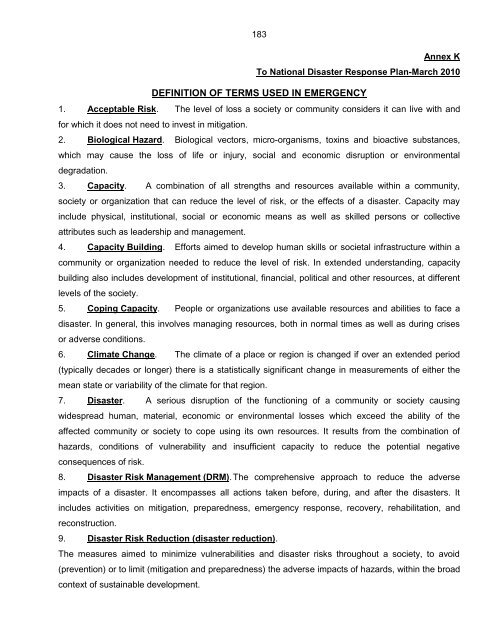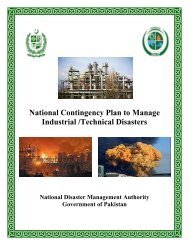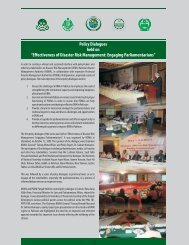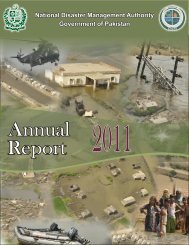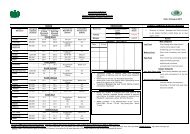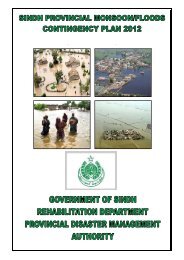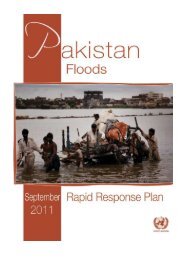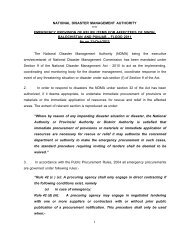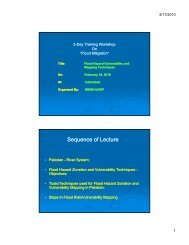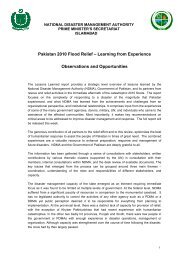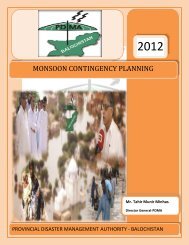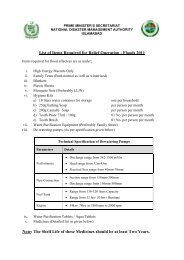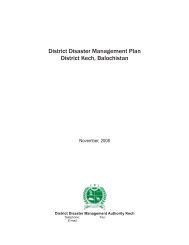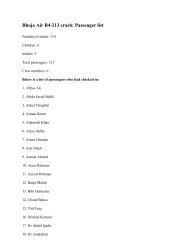National Disaster Response Plan (NDRP) March 2010 - NDMA
National Disaster Response Plan (NDRP) March 2010 - NDMA
National Disaster Response Plan (NDRP) March 2010 - NDMA
You also want an ePaper? Increase the reach of your titles
YUMPU automatically turns print PDFs into web optimized ePapers that Google loves.
183<br />
Annex K<br />
To <strong>National</strong> <strong>Disaster</strong> <strong>Response</strong> <strong>Plan</strong>-<strong>March</strong> <strong>2010</strong><br />
DEFINITION OF TERMS USED IN EMERGENCY<br />
1. Acceptable Risk. The level of loss a society or community considers it can live with and<br />
for which it does not need to invest in mitigation.<br />
2. Biological Hazard. Biological vectors, micro-organisms, toxins and bioactive substances,<br />
which may cause the loss of life or injury, social and economic disruption or environmental<br />
degradation.<br />
3. Capacity. A combination of all strengths and resources available within a community,<br />
society or organization that can reduce the level of risk, or the effects of a disaster. Capacity may<br />
include physical, institutional, social or economic means as well as skilled persons or collective<br />
attributes such as leadership and management.<br />
4. Capacity Building. Efforts aimed to develop human skills or societal infrastructure within a<br />
community or organization needed to reduce the level of risk. In extended understanding, capacity<br />
building also includes development of institutional, financial, political and other resources, at different<br />
levels of the society.<br />
5. Coping Capacity. People or organizations use available resources and abilities to face a<br />
disaster. In general, this involves managing resources, both in normal times as well as during crises<br />
or adverse conditions.<br />
6. Climate Change. The climate of a place or region is changed if over an extended period<br />
(typically decades or longer) there is a statistically significant change in measurements of either the<br />
mean state or variability of the climate for that region.<br />
7. <strong>Disaster</strong>. A serious disruption of the functioning of a community or society causing<br />
widespread human, material, economic or environmental losses which exceed the ability of the<br />
affected community or society to cope using its own resources. It results from the combination of<br />
hazards, conditions of vulnerability and insufficient capacity to reduce the potential negative<br />
consequences of risk.<br />
8. <strong>Disaster</strong> Risk Management (DRM). The comprehensive approach to reduce the adverse<br />
impacts of a disaster. It encompasses all actions taken before, during, and after the disasters. It<br />
includes activities on mitigation, preparedness, emergency response, recovery, rehabilitation, and<br />
reconstruction.<br />
9. <strong>Disaster</strong> Risk Reduction (disaster reduction).<br />
The measures aimed to minimize vulnerabilities and disaster risks throughout a society, to avoid<br />
(prevention) or to limit (mitigation and preparedness) the adverse impacts of hazards, within the broad<br />
context of sustainable development.


